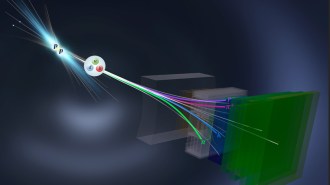Scientists finally detected oxygen-28. Its instability surprised them
Something may be missing from current theories about the strong nuclear force

Scientists had predicted that oxygen-28 would hang around for a while before decaying. But when they finally managed to create the elusive isotope in a particle accelerator, it fell apart almost immediately — shedding four neutrons (illustrated blue) and turning into oxygen-24.
Andy Sproles/Oak Ridge National Laboratory







